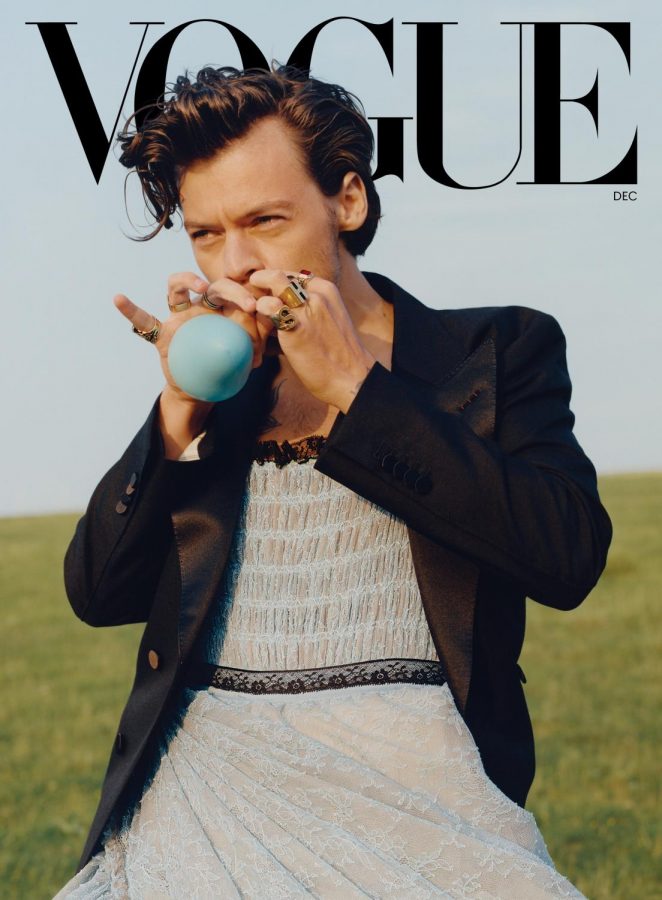“Society does not thrive on conformity, but rather diversity and individuality.”
Harry Styles’ Vogue cover is a step in the right direction
November 22, 2020
Harry Styles is on the cover of Vogue’s December issue, making him the first man to appear solo on the magazine’s cover, and he impressively stuns in a periwinkle Gucci ball gown and black tuxedo jacket. Despite the work of art this cover is, not many loved it as much as I did. Some people were actually horrified to see a man in a dress displayed on Vogue. But what is so wrong with this picture? The fact that Styles looks criminally good? Does the purpley-blue hue compliment his complexion all too well?
Well, according to Candace Owens, Harry should not be wearing a dress at all, much less should Vogue be promoting it.
Owens claims “manly” men do not wear dresses, but take a look back in history— have we not seen what she would deem “manly men ” in dresses before?
Now this past week, in a series of tweets and a nine minute Instagram video, she preached the importance of “manly” men and “normalcy”. Owens, a 31-year-old conservative political activist, author and YouTuber, said women should be feminine, and men should be masculine.
To be clear, as defined by the Merriam-Webster dictionary, the term “masculine” means “having qualities appropriate to or usually associated with a man.” So, who decided a dress was not masculine?
What is different about this man and this dress, compared to the tunics and kilts donned by vikings, knights and even Jesus among his disciples?
Dresses and skirts of different forms have been worn by men all throughout history, so I genuinely ask, what is so different? Is it the fact that tunics are simple whereas Harry’s dress is expressive and elegant?
Why does this specific image anger Owens so much? Well, in a video she posted on her instagram, Owens claims the feminization of men and the dismissal of gender norms is an “outright attack” and she even went as far as to call it a “perversion”.
I personally feel in awe of Harry when I see him on that cover, he looks ethereal in a ball gown, a look that I could only dream of pulling off.
His unabashed expression of self is beautiful. And as people see acclaimed singer, Harry Styles, flaunting a dress on the cover of Vogue, I think they too might find courage to feel ok doing something that others might not embrace.
So I ask you, Candace, ‘What is so wrong with a man in a dress?’
By saying a man cannot wear a dress because of the gender fluidity that incites, you are setting a precedent of harmful restrictions when it comes to how people can express themselves and you are pushing your own version of “normal” onto others.
You are indicating that all the little girls who call themselves tomboys as they enjoy throwing a football and getting dirty playing in the mud are wrong because they are inadvertently being too much of a boy.
You are saying all the little boys who find joy in playing with dolls and walking around the house in their mom’s high heels are wrong for not doing something more “boy-like.”
You are telling the teenage girl that she cannot wear her dad’s shirts and baggy jeans because you are putting her in a box and saying clothes have a gender and those clothes belong on a man’s body, not a woman’s.
You are telling that teenage boy to wipe off the makeup he was experimenting with and go play video games, because in a world where a man cannot wear a dress, no one can stray from what you have deemed “manly” or “girly” no matter how badly they want to.
So while Candace Owens sees Harry Styles in a ball gown as an attack on men and masculinity, I see it as an attack on the limitations and the boxes in which Owens is so desperately trying to keep people.
I see Styles display as an effort to promote individuality and to encourage others to be themselves, to do what makes them happy. I see Styles in a dress on the cover of a top fashion magazine, as a gateway for other men to feel comfortable straying from what they have been told is masculine and normal.
Society is not a monolith.
Society does not thrive on conformity, but rather diversity and individuality, and Harry Styles shows us how.



